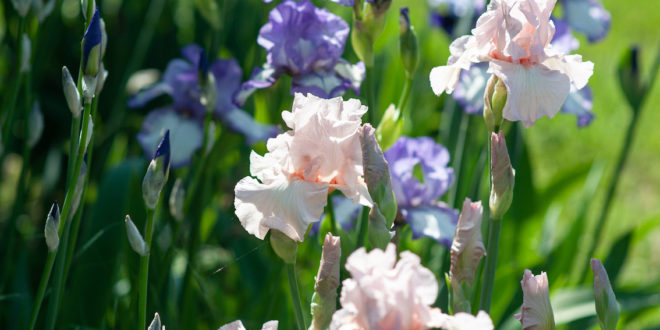If you think poppies, in their many different guises and flowering times, are confusing, wait until you meet the iris family! However, once we realise there are over 300 different species of iris, and many more cultivars (plants deliberately bred, rather than occurring naturally), we can forgive ourselves for any confusion. Although we can’t hope to know all our irises, we can acquaint ourselves with the following favourites – and the occasional undesirable.
Iris stylosa – a winter wonder
You have to love a flower prepared to bloom in the depths of winter. Iris stylosa (also known as the Algerian iris) is a hardy, undemanding plant. For most of the year it presents as a rather scruffy, short clump of what might be mistaken for grass. But then, right when we need it most, it produces delicately scented, lavender-blue blooms that sensibly tuck themselves down in their thicket as they shelter from the winter winds. Although the flowers don’t last at all in a vase, this disappointment is quickly made-up for by the fact the bush will grow in the most neglected of soils. October is the time to purchase and plant Iris stylosa.
Iris reticulata – bringer of late winter and early spring cheer
You’ll know these pretty, predominantly purple, beauties when you see them, because even though they are small (just 10-15 centimetres high), they fill such a need in us for fresh colour at the end of winter. Because they flower so early, it’s important they are grown in free draining soil. This is why you will often spot them growing in containers or rockeries. They can be planted from March through to mid May – so mark the date in your gardening diary.
Dutch Iris – a spring special
Even if you’re not a gardener, you’re sure to have encountered tightly-bunched Dutch irises in the window display of florists in early September. The deep purple and mauve blooms, trimmed with yellow, are long-lasting in a vase, which makes them such a popular cut flower. To get the look, plant the bulbs of these beautiful irises in rich, well drained soil from late March right through to May.
Bearded Iris – the summer sun-lounger
The irises we are perhaps most familiar with are the bearded varieties. We are used to seeing them growing, in a wide range of bright colours, in warm, dry situations where their rhizomes (the fat, undergrounds stems they grow from) like to bake in the hot sun. While they are said to be easy to grow, gardeners in damp, cool regions may not agree!
Bearded irises come in a range of different heights, from Dwarf (20-40 centimetres) and Intermediate (41-70 centimetres), to Tall (70 centimetres). They flower, in the same order, from late September to December, in most parts of the country, right through to January in cooler regions.
If you want these stunning beauties in your garden, plant them from December through to March for flowering the following season (because roots need time to establish before winter, gardeners in cooler regions should aim to plant by around early to mid February.
Iris pseudacorus – flag it away!
It may look a picture in a paddock or around the edges of a pond, but don’t be tempted to plant the ‘yellow flag iris’. This fast-growing, invasive pest-plant quickly becomes established, smothering other plants, and even blocking waterways. Give it a wide berth, and if you do spot it on your property, call your local council for advice on how to deal with it (whatever you do, don’t discard pieces in such a way that they have a chance of regrowing).
With all the irises that are available, there is one for almost every time of the year. Happy growing!









Join the Discussion
Type out your comment here:
You must be logged in to post a comment.